Overcoming ALTEphobia
The test results are in. What do they mean, and where do you go from here? Is treatment indicated? Should you put the baby on a monitor? What should you tell the parents? These guidelines will help you decide. Second of two parts.
Overcoming ALTEphobia
When and how to manage infants who have "spells"
By Sean Palfrey, MD
The test results are in. What do they mean, and where doyou go from here? Is treatment indicated? Should you put the baby on a monitor?What should you tell the parents? These guidelines will help you decide.Second of two parts.
When an infant has a "spell" involving apnea, choking, or colorchanges, parents and pediatrician facethe frightening question, "Howserious is it?" The answer can range from nothing to worry about toan apparent life-threatening event (ALTE). The first part of this article("Overcoming ALTEphobia: A rational approach to 'spells' in infants,"May 1999) defined the nature and physiology of certain types of "spells"infants may have in the first year of life and considered how best to evaluatethese events.
A skillful history and physical exam can often separate babies who requireno further evaluation and no intervention beyond reassuring the parentsfrom those who need a work-up for potentially worrisome problems. Testsshould be ordered parsimoniously and selected to answer specific importantquestions raised by the case. This article considers how to interpret studyresults and manage infants who are found to have particular abnormalitiesor to be at serious risk for recurring life-threatening events.
Central apnea
As noted previously, normal babies have a good deal of central apnea.Central apnea lasting less than 15 seconds is benign and does not requiremedical intervention unless the spells are associated with bradycardia orsignificant desaturation.
Central apnea lasting 15 to 25 seconds is uncommon in children under6 months of age, but it is not a serious concern unless it occurs oftenor is accompanied by bradycardia or desaturation. Normal infants older than6 months often have central apnea lasting longer than 15 seconds (Figure1), which is considered benign as long as it is not associated with bradycardia(for age) or significant oxygen desaturation.
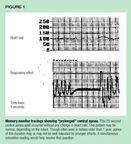
Children with repeated central apnea lasting longer than 25 seconds orshorter apnea associated with bradycardia or desaturation should be evaluatedfor infectious or central nervous system causes. If the baby has an acuteviral illness known to produce apnea, such as respiratory syncytial virus(RSV), cytomegalovirus, or adenovirus, wait it out and see if the apneapersists when the illness has passed. If the baby has meningitis or sepsis,treat the infection and check again for apnea and desaturation when he hasrecovered.
Babies with spina bifida may have horrifyingly prolonged central apnea(with bradycardia and desaturations) when they contract viruses such asRSV (Figure 2). These infants often require intubation and ventilation forseveral days, but at the end of the acute illness their sleep studies maylook normal. They should be monitored until they appear able to handle viralillnesses without developing severe apnea.
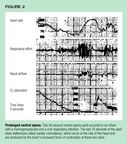
If no treatable cause can be found for apnea that is very prolonged orassociated with serious bradycardia or desaturation, or if the baby hashad seizures with true ALTEs or has a chronic condition known to place himat risk for severe apnea, monitor the infant as outlined in the discussionof monitoring below.
Periodic breathing--a rhythmic, repetitive sequence of short centralapnea--almost always reflects an immature pattern that the baby will growout of and rarely requires treatment. A baby who desaturates significantlyduring runs of periodic breathing (Figure 3) or during single short apneaspells presents several possibilities to consider. Most babies do so becausetheir resting saturations are low or their ability to maintain good saturationsis marginal. These conditions are usually caused by bronchopulmonary dysplasia(BPD) or other lung disease or a right-to-left cardiovascular shunt. Theymay require oxygen, methylxanthines, or some other treatment, either forthe underlying condition or to diminish the degree or frequency of the desaturations.
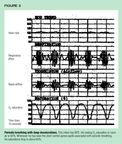
If a generally healthy premature infant has brief drops in pulse rateor desaturations into the mid-80%s during short apnea spells or periodicbreathing (Figure 4), you have to decide whether these minor, self-correctingchanges are of enough concern to bother with. In cases of concern, the usualapproach is to treat the apnea with a methylxanthine, thus eliminating theimmediate cause of the pulse drops and desaturations, and follow the childas he matures out of the problem.
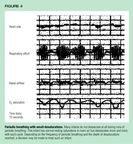
Using methylxanthines
Methylxanthines effectively decrease the incidence of short apnea andperiodic breathing and increase the respiratory force and rate in some babieswho have periods of hypoventilation. The two drugs generally prescribedare caffeine, which can be administered once a day (after loading), or theophylline,which is usually giventwice a day. Both medications act in very similarfashions, but clinicians tend to have personal preferences. Some feel thatcaffeine does not cause as much gastroesophageal (GE) reflux as theophyllinedoes, but caffeine is not as readily available in liquid form as theophylline,and serum levels of caffeine are not as easily obtained.
The effects of caffeine and theophylline are graduated, low levels ofthe drugs having some effect and higher levels having more. Thus the usualpractice is to aim for levels in the 8 to 12 mg/mL range first, to see ifthey are effective, and push into the midteens only if necessary. Once atherapeutic level has been established, the baby is usually restudied tosee if the desired physiologic effect hasbeen achieved.
Methylxanthine pharmacokinetics change quite rapidly during the firstseveral months of life, and if it is critical to maintain effective bloodlevels, both the dose and the dosing interval may have to be changed asthe baby grows older. Whenever compliance and blood level maintenance arevery important, neonatologists recommend both cardiorespiratory monitoringand periodic methylxanthine blood level measurements for any infant whogoes home on one of these medications.
We typically treat for three to six weeks to give the baby's centralcontrol time to mature. Then, if no further clinical problems have occurredand no worrisome events have been documented in a baby who has been monitored,we may stop the methylxanthines and restudy the baby off medication. Someclinicians let infants wean off the initial dose of medication by gainingweight, but this often involves longer "treatment" than necessaryand could result in undermedicating babies who require specific therapeuticlevels.
Methylxanthines are, unfortunately, much less effective at eliminatingprolonged central apnea than short apnea. Significantly prolonged centralapnea may reflect a more serious underlying neurologic condition (such asseizures, a congenital CNS anomaly, or a CNS infection) or a viral infectionin a premature infant. These etiologies should be sought and treated ifpossible.
Hypoventilation
All babies have periods of shallow breathing, both episodically and duringdeep sleep. If heart rate and saturations remain normal, shallow breathingis not cause for concern and should not be treated.
Sometimes periods of shallow breathing are associated with minor degreesof desaturation and somewhat slow heart rates. These are rarely a seriousconcern. They do suggest, however, that the baby has marginal ability tomaintain good saturations and that mild pulmonary disease or pulmonary orcardiac shunting may be present. Intermittent, mild degrees of desaturationare probably not of great concern, but treatment with a methylxanthine oftenimproves respiratory drive, thoracic expansion, and heart rate just enoughto eliminate the desaturation.
Bradycardia and tachycardia
Of all the findings under discussion, bradycardia is probably the mostclearly indicative of true physiologic distress and should always be carefullyevaluated. Bradycardia is rarely a presenting complaint except when theinfant is being monitored, but its association with apnea, cyanosis, orabnormal tone or motor activity reflects the seriousness of those episodes.
In general, we consider a heart rate of 100 to be the lower limit ofnormal for an infant after less than 38 weeks' gestation, 80 for term infantsfrom birth to 2 months of age, 70 for 2- to 4-month-olds, 60 for 4- to 6-month-olds,and 50 for older infants. These norms should not be considered absolute,however. Infants whose resting heart rates are higher than usual may haveclear "bradys" at rates higher than these. On the other hand,some apparently normal newborns have low resting heart rates (90 to 120)for the first five to 10 days of life. When these infants have little pulsedrops in the normal course of the day, they often reach "bradycardic"levels, but these "events" are clearly well tolerated. As longas they are not associated with serious apnea or desaturation, they shouldbe considered benign and simply followed clinically as the pattern resolvesover the next week or so.
Babies also develop sinus arrhythmia by 6 to 8 months of age, and theirheart rates drop quite low during quiet breathing. The lowest heart ratesduring these patterns are good guides to what the baby's body considersnormal.
Premature babies and other infants with increased vagal tone and immaturecentral control of heart rate often show a drop in pulse rate in responseto minimal stimuli such as swallowing, valsalvas, and short central apnea.Episodes that are brief and not associated with cyanosis or desaturationare rarely treated and usually diminish in depth and frequency over thenext few weeks as the baby matures.
Significant bradycardia may accompany other events, such as central orobstructive apnea or seizures.In these cases, the precipitating event shouldbe evaluated and treated if possible. Using methylxanthines to treat centralapnea that causes bradycardia often decreases the frequency of the apnea,and thus the frequency of the bradycardia, as well as blunting the depthof the pulse drops. If obstructive apnea seems to be the cause of the bradycardia,treat the obstruction, not the bradycardia.
Treating seizures in premature infants should eliminate associated apneaand bradycardia but will have no effect on immaturity of central controlof heart rate or respiratory effort. Thus, a baby treated successfully forseizures may still have episodes of apnea and bradycardia related to immaturity.In such cases, use methylxanthines with great caution since they could lowerthe threshold for seizures again.
Pertussis is one of the few acute infections, other than bacterial sepsis,that often causes bradycardia. During paroxysms of coughing (Figure 5),the baby's heart rate and saturation may drop simultaneously and dramatically,then rise and fall in progressively smaller cycles over the next three tofive minutes. These patterns diminish as the paroxysms become less severe,but pulse drops may persist for several months.
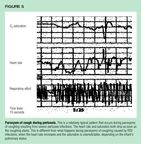
If the cause of bradycardia is unexplained, or if the pulse drops areunusually deep, prolonged, or frequent, a cardiologic evaluation shouldbe undertaken. If no etiology can be identified, the baby may have to bemonitored so that caretakers can respond promptly to reverse the event.Medications such as atropine are rarely used in infants except for specificindications.
Occasionally, episodes of tachycardia are clearly documented in a babywho has spells. If supraventricular tachycardia occurs, it should be evaluatedand treated in standard ways, but it rarely explains a spell. Slight elevationsof heart rate are sometimes noted in infants with histories of ALTEs, butin the absence of other worrisome features this observation should simplybe followed clinically.
Desaturation
Many normal babies occasionally desaturate into the low 90%s and eventhe high 80%s under certain circumstances, usually with apnea or hypoventilation.Such brief desaturations may occur five to 10 times during a 12-hour study.They usually last five to 10 seconds and are not associated with bradycardia.If episodes of desaturation are associated with bradycardia or persist longerthan a few seconds below 90%, they are cause for concern and should be evaluated.
Many premature infants who have had pulmonary disease but no longer needoxygen to keep their resting saturations in the high 90%s desaturate forminutes or hours into the low 90%s during deep sleep. They may have mildBPD and lungs that are not yet normal, or right-to-left cardiac or pulmonaryshunts. When such infants feed or have any form of apnea, their saturationswill drop further, often deep into the 80%s.
Such babies are at risk for desaturation during otherwise minor respiratoryillnesses. If they still have immature central control of respiratory effortand heart rate, they may be at risk for more apnea and bradycardia as well.Because even transient stresses produce desaturation, these infants needto be followed carefully, but there is no evidence that this condition,per se, places them at greater risk for SIDS than any other comparable child.
Episodes of circumoral or acrocyanosis are not necessarily associatedwith central desaturation. Peripheral cyanosis may simply reflect localchanges in circulation (but can cause drops in oximetry readings on affecteddigits). If a baby has significant central cyanosis without apnea or bradycardia,look for pulmonary and vascular causes. If you find a chronic conditionthat predisposes the child to frequent desaturations, you have to decideif the periods of desaturation are serious enough to treat directly or indirectly,with oxygen, for instance.
Premature babies who have long runs of periodic breathing may have progressivelydeeper desaturations during these patterns. Desaturation is not always adangerous condition. As in the cases of children with asthma, pneumonia,or right-to-left shunts, who may live safely with intermittent or chronicallylow saturation levels for days, weeks or months, you must decide whetherthe desaturations are worrisome enough to treat. If you are very concerned,you can treat the periodic breathing with theophylline or caffeine, to whichit is exquisitely sensitive.
Obstructive apnea
All babies have partially obstructed breaths and short episodes of mixedapnea. These often result from awkward head position or floppiness of thetongue, palate, or pharyngeal tissues. Even a complex sigh can sound orlook like transient obstruction. In general, minor events last three tofive seconds, and the baby catches his breath with little effort. Sometimesinfants have several of these transiently obstructed breaths in a row, eachcorrecting spontaneously. During these breaths, the baby's heart rate usuallygoes up (because of the activity), a lot of motion artifact appears on themonitor tracing, and the baby may reflux. If the baby's heart rate goesdown during his struggle to overcome obstruction, itsignifies that he isbeing seriously stressed. Mixed central and obstructive apnea can also causebradycardia and desaturation (Figure 6).

The severity of an obstructive spell can be difficult to determine froma sleep study tracing because the movement involved in an infant's struggleto catch his breath often creates artifacts in all channels, especiallythe saturation and heart rate channels, and because lack of nasal airflowdoes not always mean obstruction, especially when an infant is old enoughto breathe through his mouth. If, however, the heart rate or the saturationtracings seem to drop in a physiologic way when the respiratory tracingssuggest obstruction, suspect significant obstructive apnea.
Documented recurrent, significant obstruction in the absence of GE reflux(Figure 7) requires a careful evaluation of the child's airway, responseto head, neck, and trunk positioning, and possibly swallowing mechanics.On rare occasions, babies are unable to sense or respond to obstruction,cannot switch from nasal to oral breathing, or are very hypotonic and donot have the strength to raise their heads or open their airways. Theseinfants need extremely careful positioning and follow-up. They are one ofthe few groups of children with obstructive apnea who might benefit frommonitoring.
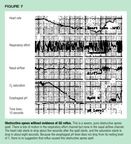
With or without a clear etiology for obstructive apnea, airway managementis the treatment of choice. Memory monitors are almost never useful in alertingus to or documenting obstructive apnea. They do not measure airflow, andthe body movement involved in overcoming obstruction causes so much artifactthat the monitor thinks it is seeing active respiratory effort and lotsof heart rate activity, so it doesn't go off.
Educating caretakers about ways to prevent choking and suffocation isvery important. Since infants can choke on small, hard objects and can smotherin soft bedding and stuffed animals, provide anticipatory guidance to parentsat or before birth about placing infants on their backs when sleeping, positioningthem so that their heads are well supported, and other routine safety issues.National campaigns stressing "back to sleep" positioning haveclearly helped to reduce SIDS rates in countries around the world.
Many preemies have had difficulties with saturation and obstructive apneaand some have less strength and lower muscle tone than full-term infantsat the time of discharge from the hospital. Check to make sure that suchbabies can maintain good airflow and saturations while sitting in the infantseats they will travel home in.
pH drops (GE reflux)
GE reflux is a normal phenomenon. In a 12-hour period, almost all babieshave short periods of reflux manifested by drops in esophageal pH to below4. They may have as many as a dozen pH drops, which usually last less thanthree to four minutes.
Normal infants choke on refluxed or vomited material from time to time,and we usually use clinical criteria to decide whether, and how aggressively,to treat the reflux. We treat babies who are not growing because they refluxso much, those who have symptomatic esophagitis or aspiration pneumonia,and those who choke frequently or severely on refluxed material.
Correlations between documented reflux and clinical or physiologic abnormalitiesare very helpful. Reflux often follows obstructive apnea (Figure 8) andis probably caused by the motion and pressure changes associated with theapnea. If such a pattern is not associated with further signs of choking,do not treat the reflux automatically. If pH drops are followed immediatelyby serious obstructive apnea, bradycardia, or desaturation, consider themrelated, though not necessarily causally, and treat the reflux. Infantswith reflux should not be monitored unless medical and surgical managementhas failed and the baby has required vigorous stimulation to overcome aserious episode of obstruction.

Simultaneous spells
Some preemies, or infants with sepsis or neurologic dysfunction, haveperiods of simultaneous hypoventilation (apnea or hypopnea), bradycardia,and desaturation. The unusual feature of these spells, which reflects aworrisome etiology, is that the heart rate and saturation drops do not followthe respiratory changes but start at about the same time or even beforeand thus seem to be caused by the same, presumably neurologic, event.
Simultaneous spells are of serious concern. If they appear suddenly orare associated with clinical deterioration, look for acute causes of CNSdisease, such as bacterial or viral meningitis, encephalitis, or sepsis.If simultaneous patterns are found during evaluation of apnea and bradycardiain a moderately stable preemie, suspect seizures, metabolic disorders, orCNS dysfunction related to more chronic entities such as intraventricularhemorrhage and "congenital" infections, and strongly consideran EEG and other appropriate studies. If seizures or encephalopathy arefound and the baby has had a real ALTE, we both treat and monitor him untilhe grows out of this pattern, which often happens over the next one to threemonths. Treatment may include anticonvulsants or methylxanthines, or both.
Serious spells but no findings
If a strong baby has real life-threatening spells and you can find nocause, consider further work-up under the direction of a neurologist orcardiologist, depending on the clinical history. If no etiology is found,the baby should be monitored. If other infants in the family have had life-threateningevents or died of SIDS, all stops must be pulled out to evaluate both medicaland social causes. Rare metabolic, neurologic, and cardiologic causes shouldbe checked and home visits made to assess the home situation and the parents'ability to care for the child. If no treatable cause is found, these childrenmust be monitored.
Serious cases of abuse, Münchausen by proxy, and attempted murderdo occur, but rarely (an estimated two to three per 1,000 monitored patients),and we must be careful not to make appropriately anxious parents feel accusedof wrongdoing or incompetence. If abuse is suspected, however, extremelycareful evaluation must be undertaken with the knowledge and assistanceof social services and often the police.
Managing anxious parents
All parents are anxious when their baby has a spell, especially if theyhave lost a child to SIDS or have had a previous child with serious problems.Physicians, too, are anxious, primarily because they do not want any childto come to harm, but, also, to some degree, because they fear that theycould be sued if a child dies.
If we find a "disease," such as reflux or even seizures, wehave an explanation for the baby's parents, and this is very helpful. Afterdiscussing the problem and approach to management, also discuss the chancethat the baby could have a similar "spell" and how the parentsshould handle it.
If the child seems to be at no unusual risk for SIDS or ALTEs, spendwhatever time is necessary to allay the family's anxiety. You can explainthat many patterns, like choking and central apnea, appear worrisome butare in fact completely normal. Admit that you cannot guarantee any child'swell-being but can assure them that their baby is at no greater risk ofSIDS than any other normal child. Sometimes a home visit, frequent officevisits, or discussions with a parent who has been through a similar situationcan be very helpful.
If the family still feels very frightened, however, we have to address,and sometimes treat, their anxieties as real medical and therapeutic problems.If, for example, it is clear that no matter what you say, the parents willtake turns staying awake watching the baby breathe all night, the best approachmay be to monitor the baby. You can frame such an agreement to monitor asa bargain of sorts. Arrange the monitoring for a specific period of time(usually one to three months). Then, if the baby does well and the memorymonitor downloads show no events or patterns of concern, everyone agreesto stop the monitoring.
When to monitor
The decision to monitor should be made jointly by the parents and primarycare physician. In addition, either a neonatologist (in the case of neonatalproblems) or an apnea specialist is often involved.
In 1986, the National Institutes of Health convened a Consensus DevelopmentConference on Infantile Apnea and Home Monitoring. Almost all of the conclusionsand recommendations contained in the group's 1987 consensus statement remainvalid 12 years later (see box, "1987 NIH recommendations on home apneamonitoring").
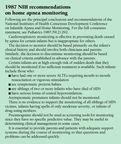
Monitoring makes many normal routines of daily life very difficult, andthe parents may interpret the decision to monitor as a tacit affirmationthat you believe the baby to be at serious and unusual risk for a trulylife-threatening event or death. In most circumstances, the problems ofmonitoring far outweigh any real benefit.
Do not monitor for transient episodes of choking, reflux, apnea, bradycardia,and cyanosis that were not life-threatening. Only if an event is truly life-threateningand you cannot discover its cause, or you find a cause that you cannot treat,should you consider monitoring.
Despite stories of infants "saved" after an alarm went off,the efficacy of monitoring has not yet been determined. There is certainlyno justification for blanket decisions to monitor whole classes of children,such as all preemies or all children of drug abusing parents. Nor is thereany evidence that monitoring all siblings of children who have died of SIDSis effective or worthwhile.
On the other hand, if a premature infant continues to have episodes ofserious apnea, bradycardia, or desaturation that require vigorous stimulationto reverse, monitoring may allow the infant to go home from the hospitalsooner than would otherwise be possible. If a baby has a spell that wastruly life-threatening, and we can find no cause to treat or any way todiminish the chances that it will recur, we may decide that monitoring isthe only alternative to continuous professional observation.
Monitoring will not prevent a spell and is not a method of treatment.If, for instance, a child has serious choking or bradycardic spells onlyduring feedings, the parents should always be with the child at those times,and monitoring may provide no added benefit. Explain that monitors do not"save" lives, but they can give warning of the onset of certainworrisome patterns that parents may then be able to respond to in a timelyfashion.
The most worrisome spells are those that seem life-threatening but thatwe cannot characterize well, cannot explain away as benign, and cannot identifya treatable cause for. One of the most common of these is a central apneaspell during sleep associated with serious color or tone changes that supposedlyrequired resuscitative efforts to reverse. Such an episode is not consistentwith any of the normal patterns or common illnesses I have discussed. Determiningif and when it recurs may require such careful observation during sleeptime that using a monitor is the best and, possibly only, way to proceed.
What monitors can tell us
Most commonly used home monitors check (and record if they are memorymonitors) only heart rate and respiratory effort by the same techniquesused in sleep studies. It is important to request that memory monitors alsohave the capacity to produce ECG tracings because most heart rate "alarms"are caused by motion artifact and because ECG tracings can help evaluatesuspected premature beats.
When oxygen saturation is the issue of greatest importance, oximetersmay be used to help monitor the baby. Their major problem is that they alarmso often because of motion artifact or poor lead attachment. They are mosthelpful if the baby's desaturations are associated with central apnea orhypoventilation (Figure 9), when there is little body motion artifact. Theyare no help if the desaturations are associated with obstructive apnea,when body motion artifact is significant.
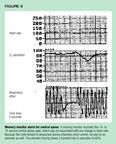
All a monitor does is let us know when it "thinks" somethingis happening. More than 90% of alarms reflect normal or benign events. Evenif we can confirm that something "real" has happened or is happening,there is a vast difference between the reality of the event and its significance.Intervention during an event is very rarely needed, but parents tend tofeel that their actions were critical every time they stimulate the baby.Unfortunately, the perception that they are needed further deepens theirreliance on the monitor.
For all these reasons, every child being monitored at home must havea monitor with a memory that records each event. It is only with this technologythat clinicians and the family can learn something about what happened whenthe alarm went off. A monitor without a memory just goes off, and thereis no way of telling whether anything serious happened or not. Monitorswithout memories are only useful in the extraordinary case of the baby whohas an occult event that would have progressed to death if the parents hadnot been alerted.
Memory monitors allow us to evaluate each episode to see if it is "real,"and they can document changes in the frequency of "real" eventsover time. Clinicians determine how long to monitor a baby based on theseverity of the worrisome event(s), the frequency and severity of the eventsseen on memory monitor "downloads," and the timing of the lastclinically worrisome event causing cyanosis or requiring active stimulation.
What to teach parents about monitors
It is essential to explain to the infant's parents the reasons for monitoring,what you will learn from memory monitor downloads and the parents' reports,how caretakers should and should not respond, and when you will discontinuemonitoring. Emphasize that monitoring itself is an invasive and frighteningtechnique for families. At home, as in the hospital, alarms go off frequently,and parents respond anxiously. Explain the causes of specific alarms andhow to differentiate between serious episodes and minor (or artifactual)ones. These judgments are based primarily on how the baby looks at the timeand what type of event is indicated by the monitor.
Instruct parents to turn on the lights so that they can see well andwatch their baby for five to ten seconds whenever an alarm goes off. Mostof the time, the baby will look fine and the alarm will turn off on itsown. This becomes reassuring to parents as they get more experienced. Thepercentage of "real" events is tiny in all but the most severelyill children, and these children usually can be identified on the basisof their history and the frequency and severity of the events witnessedbefore they go home from the hospital.
The baby should be on the monitor at whatever times you feel he is atrisk, usually when he is asleep and there is no one present to watch andstimulate him if needed. Infants who are awake and being held by their parentsusually don't need to be monitored. Children have died "on monitors,"but most of them were not actually attached to their machines at the timethe fatal event occurred.
Counsel families at every opportunity to place the baby on his back tosleep rather than on his stomach, not to smoke or take drugs of abuse, andto avoid excessive ambient heat and unsupported body positions. All of thesefactors are known to increase the risk of spells.
Reviewing memory downloads
The memory of a monitor should be downloaded to review the cardiac andrespiratory effort tracings whenever the baby has what might have been aserious spell and at routine intervals, such as every three to four weeks,to see if the baby has had any worrisome patterns or events that were notidentified clinically. The download shows physiologic correlates (or lackthereof) of witnessed events, documents any unwitnessed events, and chroniclesmaturation of the infant's central control of heart rate and respiratoryeffort over time.
Downloads are usually performed routinely by the monitoring company'stechnicians. The primary care physician or consulting specialist (interpretingphysician) can request them at any time.
Reviewing downloaded records can sort most real events from artifacts.Leads that are not attached properly result in poor signals that the monitorcannot interpret. Whenever the baby is active, the tracings may fluctuatewildly, and the input signals may look to the monitor like tachycardia orbradycardia. Alternatively, normal shallow breathing may look like apnea.If the alarm settings are not changed as the child grows, the monitor willgo off for "events" that are well within normal limits for aninfant that age (Figure 10).
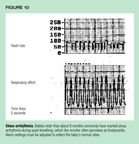
Good tracings also record events of unclear meaning, just as sleep studiesdo. In babies who have obstructive apnea, motion artifact makes it impossibleto determine whether or not the baby was moving air. Motion artifact canalso completely hide bradycardic events. As mentioned previously, this isone reason that monitoring infants with GE reflux and other potential causesof obstructive apnea is problematic and usually not helpful.
Shallow breathing may be normal, as long as the baby's heart rate andsaturations remain stable. If the baby's heart rate drops significantly,it probably means that the shallow breathing is physiologically stressful.If the heart rate does not dip, the baby may well be fine, but we have noway of knowing if the child has become desaturated during these periodssince most monitors provide no oximetry tracing. Experience with multichannelsleep studies is generally reassuring, however, in that periods of shallowrespiratory effort without pulse drops are rarely associated with seriousdesaturations (unless the baby has an underlying condition such as BPD).This situation exemplifies the uncertainties involved in monitoring.
Deciding how long to monitor
How long monitoring should continue depends in part on the cause of concern.We monitor preemies with a history of apnea and bradycardia long enoughto document that their central control of respiratory effort and heart ratehas matured. This usually ends up being two to four weeks without a clinicallyworrisome event including cyanosis or requiring vigorous stimulation andno serious physiologic events on the memory monitor's downloads. Minor pulsedrops and central apnea may still be occurring at the time monitoring isdiscontinued, so the decision should be made jointly by the primary careand interpreting physicians and carefully explained to the parents.
If a term baby has had an unexplainable, life-threatening event, we cannotfeel comfortable that maturation will make recurrence less likely, and wemay want to watch the baby longer, often two to three months without a seriousepisode. Other elements, such as the season, also come into play. If itis winter and the world is filled with respiratory viruses, it may be smartto monitor an immature infant longer and even through a viral illness tosee how he does. Obviously, all viruses are not equally likely to causeapnea, and a baby may go for months without getting a virus, so practicalconsiderations have to be taken into account as well.
Parents who have lost an infant to SIDS sometimes want to monitor subsequentchildren until they pass the age at which the previous baby died. This isa tough situation. The incidence of repeat SIDS deaths in a healthy siblingis very low. On top of this, there is no reason to predict that any subsequentdeath will occur at a similar age. Parents know, however, that SIDS is commonestbetween 1 and 6 months of age and often want to extend monitoring untilthe baby is at least 6 months old.
Do everything you can, for the sake of both the parents and the baby,to reassure parents that it is safe not to monitor a normal sibling of achild who has died of SIDS. If you cannot reassure them, they need to knowthat most insurance plans will not pay for a monitor, for the very reasonsI have been discussing. If they choose to monitor, encourage them to monitorthe new baby for a relatively short period of time with realistic goalsin mind--such as two or three months with no events. In the end, though,you have to make the decision jointly with them, based on many factors,and weigh the best interests of everyone.
Follow-up
The frequency of clinical follow-up of babies who have had ALTEs dependson the etiology of the spells, if known, the need to check medications,the anxiety level of the parents, and the timing of monitor downloads (usuallyonce a month and prn, depending on worrisome events). Making yourself availableto parents by phone often obviates frequent office visits. Parents are usuallyinstructed to contact their monitoring companies, all of which should have24-hour service, if the machine is alarming frequently and the baby seemsfine, which is often the case.
A balanced approach
Few "spells" are so serious that they qualify as ALTEs. Inmost situations, after a systematic evaluation, we can identify a probablecause and estimate a risk. We must evaluate children in the simplest andmost specific ways possible to assess these causes and risks.
Many spells don't require treatment. If, however, we discover a conditionfor which we have an effective treatment, such as a seizure, and the benefitsof treatment outweigh the risks, we obviously treat. We must apply the samerigor to decisions about whether and how to treat whatever we find duringthe evaluation of a child with a true ALTE. If we cannot identify a cause,or have no treatment, we may have to monitor the baby for a while to seeif an ALTE recurs.
Just as we distinguish most "spells" from ALTEs, we must keepthe concept of ALTE distinct from that of SIDS. By definition, we are unableto identify the cause of death in a child with SIDS, and we cannot predictor prevent specific cases of SIDS. We treat the cause of an ALTE to preventthe ALTE from recurring, not to prevent a SIDS death. We know that all infantsare at some tiny risk of SIDS, and until we clarify the various conspiraciesof circumstances that cause SIDS, we have to accept some risk. It is veryimportant to help parents understand this truth as well.
We cannot guarantee any baby's well-being, but simple measures--suchas good prenatal care, "back to sleep" positioning, not smokingor using drugs, placing no soft bedding or stuffed animals in the crib,and keeping the baby comfortably cool while asleep--seem to prevent SIDSmore effectively than any therapeutic intervention we have yet devised.
THE AUTHOR is Clinical Professor of Pediatrics at Boston UniversitySchool of Medicine and Attending Pediatrician at Boston Medical Center,Boston.
The author gratefully acknowledges the support of Judith S. Palfrey,MD, without whose urging this article would never have been written, andthe advice and counsel of Michael J. Corwin, MD.
SUGGESTED READING
Filiano JJ, Kinney HC: Sudden infant death syndrome and brainstem research.Pediatr Ann 1995:24:379
Freed GE, Steinschneider A, Glassman M, et al: Sudden infant death syndromeprevention and an understanding of selected clinical issues. Pediatr ClinNorth Am 1994;41(5):967
Garg M, Kurzner SI, Bautista DB, et al: (1988) Clinically unsuspectedhypoxia during sleep and feeding in bronchopulmonary dysplasia. Pediatrics1988;81:635
Gibson E, Spinner S, Cullen JA, et al: Documented home apnea monitoring:effect on compliance, duration of monitoring, and validation of alarm reporting.Clin Pediatr 1996;35(10):505
Hunt CE, Beckerman RC, Brouillette RT (eds): Respiratory Control Disordersin Infants and Children. Baltimore, Williams & Wilkins, 1992
Hunt CE, Hufford DR, Bourguignon C, et al: Home documented monitoringof cardiorespiratory pattern and oxygen saturation in healthy infants. PediatrRes 1996; 39(2):216
Keens TG, Ward SL: Apnea spells, sudden death, and the role of the apneamonitor. Pediatr Clin North Am 1993; 40(5):897
National Institutes of Health Consensus Development Conference on InfantileApnea and Home Monitoring: Consensus statement. Pediatrics 1987;79(2):292
Meny RG, Carroll JL, Carbone MT, et al: Cardiorespiratory recordingsfrom infants dying suddenly and unexpectedly at home. Pediatrics 1994;93(1):44
Schwartz PJ, Southall DP, Valdes-Dapena M: 1988: The sudden infant deathsyndrome: Cardiac and respiratory mechanisms and interventions. Ann NY AcadSci 1988; 533:1
Southall DP, Plunkett MC, Banks MW, et al: Covert video recordings oflife-threatening child abuse: Lessons for child protection. Pediatrics 1997;100(5):735
Southall DP, Richards JM, Rhoden KJ, et al: Prolonged apnea and cardiacarrhythmias in infants discharged from neonatal intensive care units: Failureto predict an increased risk for sudden infant death. Pediatrics 1982;70:844